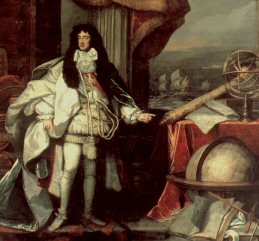
King Charles II depicted as the President of the Royal Society.
On April 22, a vast cohort of scientists and their allies descended on Washington to take part in the DC March for Science. Researchers and educators, academics and civilians, town and gown, stood together to “express their fealty to reason, data, and, above all, the scientific method,” as a recent New Yorker article put it. Striking back at a Administration that has openly denied scientific consensus on issues such as climate change, even going so far as to purge scientific data from government servers, scientists marched against what seems to many like a sudden and shocking politicization of science.
The experts don’t get to tell us what the facts are, the new Know-nothings say, and so dismiss inconvenient truths as nothing more than the ideological impositions of a liberal elite. In response, the marchers planned less a day of protests than a public witnessing for the core values of objective truth, empirical inquiry and peer review. The event they planned would be something like a cross between a protest rally and a science fair, where researchers set up tents and hold teach-ins about just what it is that they study and why it matters to the public. Organizers intended to put pressure on politicians to heed scientific expertise, but they were also looking to put on the kind of show that would win back both the hearts and the minds of America. Nevertheless, there was handwringing among some scientists who feared the march would “trivialize and politicize the science” and turn scientists into just “another group caught up in the culture wars.”
As the Pacific Standard has rightly pointed out, we should not be so quick to assume that science has never been and shouldn’t be politicized. The scientist as a non-partisan figure is a cold war innovation, Francie Diep points out, born of a time when the government began investing heavily in university science programs, and when there was leverage in taking the position that “scientific ideas were apolitical and value-neutral.”
But there’s a much longer and complex history here. In fact, modern science as we understand it — the empirical study of natural phenomena, the accumulation of experimental facts that lead to hypothetical explanations, in short, the scientific method — was the product of a late 17th century controversy about the value of experimental knowledge. Early modern debates bout the reliability of science and the trustworthiness of the scientist are remarkably similar to the controversy we find ourselves in today. Few of us realize that in its very moment of emergence, modern science had to invent the concept of scientific objectivity in order to prevent it from being strangled in its cradle by scoffers.
It’s jarring to learn that the earliest criticisms of science are coming back to the fore today. In the Post-Truth, Post-Trump world, scientists fear that their hard-won expertise is not being respected anymore, while skeptics delight in calling bullshit on their claims to objectivity. Scientists point to data sets, experimental controls, and peer review, while deniers will say that science can be little more than a flim-flam: a dog-and-pony show that tries to dazzle us with data while pushing an ideological agenda.
It’s like its 1676 all over again.
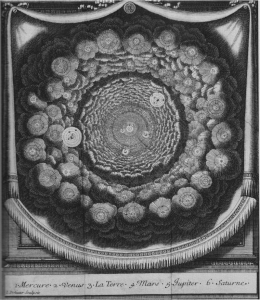
I have only to draw the curtain, and to show you the world” cries the proselytizing Philosopher in Bernard Fontenelle’s best-selling work of popular science, Conversations on the Plurality of Worlds. This frontispiece illustration to a 1686 edition pulls back the curtain on the thrilling spectacle of an infinite universe.
For at least a generation, scholars of history, sociology and cultural studies in the emergent interdisciplinary field of Science Studies have been exploring the struggle to define science as a discourse of empirical truth. Of particular relevance to the March For Science is a body of work that reminds us of early modern science’s debts to spectacle, theatricality and performance: the modern fact had to be fabricated through the making of experiments, and those facts had to be witnessed and verified by experts in order to be approved as such. Early science really was a kind of performing art, subject to regimes of stagecraft that reverberated across the laboratory, the lecture hall, the anatomy theater, and the public stage.
This kinship was not lost on their early scientists’ contemporaries in the playhouse, which used that powerful platform for the shaping of public opinion to interrogate the new science and its radical new claims about the nature of knowledge. Indeed, the way that eighteenth-century plays depicted scientists had a massive influence on contemporary debates over the role that experimental science was to play in modern life. The new science got terrible press until it could establish itself as objective, reasonable and disinterested. But the theater shaped the very form that science itself was to take. By disciplining, and ultimately helping to legitimate, what was then called natural philosophy, the eighteenth-century stage helped to naturalize an epistemology based on self-evident facts that one need only see to believe. However, in oder to do this, scientists had to make recourse to elements of spectacle and performance that proved difficult for them to square with their need to present their work as objective, “apolitical and value neutral.”
A Shining Instance of the Scientific Method
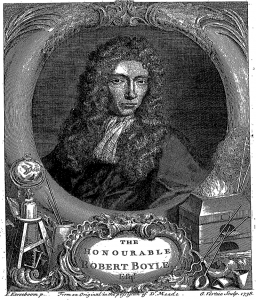
Frontispiece portrait from a 1738 edition of Boyle’s collected Works.
To put some flesh on the bones, as it were, of this history I am trying to sketch, I need to tell the story of this man. This is Robert Boyle, pictured here a few decades after his death, in the frontispiece illustration that appeared in a posthumous edition of his Works. The youngest son of the Earl of Cork, one of the wealthiest men of the seventeenth century, he was an aristocrat by birth but a scientist by calling. This unmarried, deeply pious son of extraordinary privilege spent his life “addicted to natural philosophy” as he memorably put it, and he was a key patron and prime mover of the Royal Society, one of the earliest scientific organizations. Indeed, Boyle was England’s most eminent virtuoso, a fashionable term adopted by Boyle and his colleagues that highlighted their supposedly selfless and virtuous dedication to the pursuit of pure knowledge.
His considerable achievements are remembered to this day in Boyle’s Law, that fundamental relationship between the pressure, temperature and volume of gases that we all learned in high school. A first-rate experimentalist, Boyle conducted foundational research into the nature of the physical world. In this frontispiece portrait, we can see to the right his chemical forge: Boyle’s work as a ”skeptical chemist” helped re-found the ancient practices of alchemy as rational modern chemistry. However, it is the apparatus on the left that we should linger over. This is an image of his celebrated airpump, and in light of the revolution it sparked in matter theory, it’s not too much to call this device the particle accelerator of the 17th century. Indeed, in his epochal New Experiments Physico-Mechanical (1661), Boyle used his airpump to overturn the ancient assumption that a vacuum could not exist in nature. He was able to contrive one under that glass dome, and in doing so discovered previously unknown properties of air — that it had weight, and that these material properties gave the air what he called “spring.”
Keeping that airpump in mind, let’s shift the scene to the night of February 15, 1672, when Boyle’s well-earned sleep was interrupted by an assistant who burst into his bedroom with some surprising news. A kitchen servant, upon going into the larder, “was frightened by something Luminous that she saw.” Intrigued, the natural philosopher leapt into action: “I presently sent for the meat into my Chamber,” he later wrote, “and then I plainly saw, both with wonder and delight, that the joint of meat did in diverse places shine.”
Boyle didn’t get much sleep that night. Instead of going to bed, he launched into an hours-long series of experiments and observations on the shining slab of flesh, right there in his bedroom. In the eight-page letter he eventually published in the Philosophical Transactions, the house publication of the Royal Society and the first scientific journal in history, Boyle relates no less than eighteen distinct matters of fact, such as:
- a) the neck of veal glowed in upwards of twenty different areas, most of them no bigger than a man’s fingernail;
- b) the “more resplendent spots” were sufficient to read by. Boyle happened to have a copy of the Philosophical Transactions by him, and he could make out a few letters on the title page;
- c) the light emitted was generally “a fine greenish blewe,” kind of like glowworms;
- d) it did not emit heat, as affirmed by the touch of a bare hand, as well as by the application of “a seal’d Weather glass”;
- e) no one could smell “the least degree of stink”;
- f) the wind was out of the southwest that night, blustery and warm, air pressure was 29 3/16 inches of mercury, the moon past its last quarter;
- g) the light was extinguished in pure alcohol, but water would not quench it.
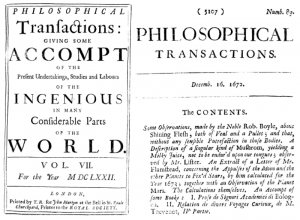
Other articles published that month presented new astronomical calculations, reviewed a recent book of “curious voyages”, and a described a “singular kind of Mushroom” whose “Milky Juice, [is] not to be endur’d upon our tongues.”
Yet the standard critical story about the emergence of modern science sounds very different notes. Mostly, we hear about the modesty and probity of early scientists, and the care they took to produce what we now recognize as scientific objectivity. Perhaps the most influential account of early experimental science, Steven Shapin and Simon Schaffer’s Leviathan and the Air-Pump: Hobbes, Boyle, and the Experimental Life (1985), explains how natural philosophers carefully performed and re-performed their experiments in semi-public assemblies until all those present arrived at a consensus about the findings. They then wrote up their experiments in often excruciating detail so that absent virtuosi could “virtually witness” the new facts and thus give their approbation to new discoveries. They deliberately restricted themselves to empirical accounts of the bare matters of fact that their experiments produced, thereby avoiding the paralysis of theoretical arguments. And, crucially, they adopted gentlemanly codes of behavior that dictated how one ought to make truth claims, and indeed, who gets to speak the truth in the first place.
These forces combine to give birth to what were then absolute novelties in human history: the fact that speaks for itself, and the scientist who is merely its objective witness. And vouchsafing the two great innovations of early modern experimental natural philosophy — self-evident facts and scientific objectivity — was a new kind of man, a figure Shapin and Schaffer call the “modest witness.” Boyle, with his prolix, cautious experimental reports, with his dazzling new scientific instrument, and especially with his unimpeachable gentlemanly ethos, was of course their paragon and exemplar.
My own research seeks to trouble that story just a little bit. Once you read just a little outside the lines of the texts that 20th century science has deemed canonical — Boyle’s airpump experiments for example — we encounter scenes of experiment that seem very far from modesty or objectivity.
After all, in the case of the shining veal, Boyle postponed his sleep for what must have been hours, working through the night, mostly in the absolute dark, making painstaking observation after observation: inspecting, rubbing, sniffing, measuring, and defacing the raw and bloody neck of a calf that, on the sudden report of a servant, is whisked out of the larder and summoned to his bed-chamber. Instruments and contraptions are gathered from all parts of the house, data is recorded, trials are performed, and then re-performed, and a scrupulous account is produced. All of this makes me ask, what if the signal legacy of experimental science was not the modest witness’ modesty, but rather the irrepressibility of his witnessing? What if the scientist’s absolute dedication to observation betrays not a rational and ascetic erasure of self-interest, but rather a highly unstable, affective immersion in the spectacle of facts?
Riveted “both with wonder and delight” (his words), Boyle is a witness to something above and beyond bare modesty. Indeed, when Boyle reveals, at the end of his report, that he had to curtail his experiments upon learning that his niece was on her deathbed, the sudden and terrible news proves to be no real impediment at all. He writes of being “hastily called up before day[break]” with the news of her “gasping” condition, which he says left him “too much affected…to leave me any time for Philosophical entertainments.” Yet in the next breath he reports one last matter of fact about the specimen. Finding that it continued to shine the next morning. “Only this I took notice of, because the observation could not cost me a minute of an hour.” But it’s not simply that Boyle couldn’t help himself from making one last experiment before domestic responsibilities called him away. In fact, the entire experimental narrative was written the morning after the activities of the night before.
Such an absorption in the spectacles of science is entirely expected from someone who kept his eyes shut tight as his assistant refitted the airpump by candlelight, so as to not compromise his night vision….Or from someone who, in another set of experiments on a luminescent gemstone, reported that he went so far as to “take it into bed with him, and hold it a good while upon a warm part of his naked body.” Indeed, the scene of experiment is a fraught space, full of surprise and wonder and potentially unruly affect, where the experiments and experiences remain a perpetual lure for the imagination.
In their influential account of the origins of modern science, Wonders and the Order of Nature 1150–1750 (1998), Lorraine Daston and Katharine Park have argued that wonder, and the so-called “strange facts” that preoccupied early naturalists, was disciplined out of natural philosophy over the course of the long eighteenth century. But we shouldn’t be so sure that Boylean wonder was chiefly prized for, and necessarily lead to, a more rational and curious analysis of spectacular experimental phenomena. Indeed, that is precisely the impression Boyle’s contemporaries got, judging from a highly influential and long-lived satire of natural philosophers that first appeared on the stage in 1676.
Eager Spectators in the Theater of Experiment
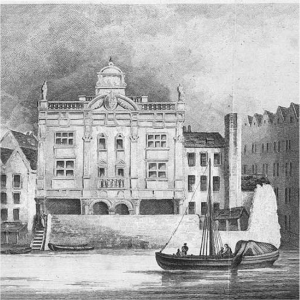
A View of the Dorset Gardens Playhouse, where Shadwell’s Virtuoso was staged.
The London playhouses were powerful sites of cultural mediation. They satirized trends, made political statements, insulted public figures, and set fashions. Accordingly, over the course of the long eighteenth century, there were dozens of plays featuring crackpot scientists, sketchy doctors, randy anatomists, doltish antiquaries, and shifty projectors peddling questionable technologies (sort of the early modern equivalent of flash-in-the-pan start-ups). But the play I want to bring into view is The Virtuoso, which was a major success for author Thomas Shadwell in the style of the hard, satiric comedy favored in the Restoration.
The play itself is a conventionally-plotted sex comedy. The misguided scientist Sir Nicholas Gimcrack and his foolish friends attempt to keep his two young, rich and beautiful nieces out of social circulation. The impecunious Gimcrack wants power over their purses, while his friends want access to their persons. The pleasure-loving young rakes Longvil and Bruce must chisel their way into Miranda and Clarinda’s affections while extricate themselves from the sexual advances of Lady Gimcrack, Sir Nicholas’ neglected wife, who spends all her time trying to cuckold him abundantly.
As delightful as all this sounds — and this play really is a lost gem — the real draw of Shadwell’s play was the new kind of fool that Gimcrack is. The “virtuoso,” in Shadwell’s telling, is fatally distracted from his proper duties as a husband, a guardian and a citizen by his useless experiments. The play’s popularity derived from how effectively it diagnosed and demolished this new species of idiot. Indeed, the play has retained a long hold on our imaginations even if most of us are unfamiliar with the source. Shadwell’s anti-hero served as a touchstone for critiques of scientific credulity and insignificance throughout the Enlightenment — a satiric “Will of the Virtuoso” was published in the Tatler a full 34 years after the play premiered. In fact, Gimcrack is the point of origin for the stereotype of the nerd scientist, hopelessly befuddled by his narrow interests, who is socially and romantically clueless for all his vanity. The precise antitype of the mad scientist (who finds his origins in Victor Frankenstein), the ghost of Gimcrack is still very much with us, as anyone who’s ever caught a rerun of The Big Bang Theory can plainly see.
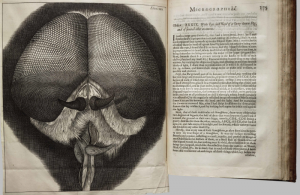
Hooke’s Micrographia afforded astonishing new perspectives on previously invisible phenomena. For some, this showed God’s awesome providence and the triumph of man’s reason. For others, it betrayed an almost pathological obsession with the mean, the lowly, the filthy, and the useless.
We know that contemporaries identified a number of satiric targets in Shadwell’s fool. Some recognized a vicious and personal lampoon on Robert Hooke, Boyle’s former lab assistant and the author of Micrographia (1667), which created a sensation with its astonishing images of the sub-visible world.
When he finally saw the play after being needled about it by frenemies, the terse account in Hooke’s diary suggests a public humiliation of the most acute kind: “Damned Dogs. Vindica me Deus. People almost pointed.” But Hooke wasn’t the only recognizable scientist parodied and insulted in the play. The play is full sharp satirical jabs at many prominent members of the Royal Society. There are blood transfusion jokes aimed at Thomas Coxe and Edward King. There are inept astronomy jokes at the expense of John Wilkins. There are quack doctoring jokes at the expense of Jan Swammerdam and Thomas Willis. Some of the best jokes are saved for Robert Boyle himself: he comes in for a roasting when Gimcrack boasts of having weighed — and bottled — air from all over England. Oh yeah, and I probably mention that Gimcrack claims to have read a Geneva Bible by the light of a rancid leg of pork.
Shadwell’s satire goes far beyond personal insults and jokes about scientific obsessiveness and credulity, though. More than anything else, the play criticizes the virtuosi for their unmindful absorption in the objects of their curiosity, and the utter disregard they show for what the real-world applications might be. In what is probably the play’s most well-remembered scene, the young suitors ask to meet Gimcrack in his laboratory — strictly for the lulz, of course. When Longvil asks, “Were it not possible to have the favor of seeing this experiment?” he seems to suggest that the virtuoso himself is a kind of experiment staged in the theater’s laboratory of human nature.
And so, at the gallant’s request, the moveable screens obscuring the Dorset Gardens’ discovery space slide back, and the audience peeps in on a remarkable scene. The stage directions read:
Scene opens and discovers Sir Nicholas learning to swim upon a table; Sir Formal and the Swimming Master standing by.
In a trice, the scene moves from a pleasant English garden to the close confines of the natural philosopher’s cabinet, “his laboratory…where all his instruments and fine knacks are.” There, Gimcrack is revealed, high and dry on a table, gravely pantomiming the motions of a frog swimming in a basin before him, with his fellow virtuosi earnestly coaching him along.
With this scene, the players have staged in Dorset Gardens another type of performer on another type of stage: a virtuoso caught mid-experiment in his laboratory, showing off for his friends in the theater of the natural philosophy. In staging what is specifically called Gimcrack’s “physico-mechanical excellencies” — deliberately echoing the title of Robert Boyle’s foundational air-pump experiments — Shadwell seems determined to paint early scientists as utterly neglectful of the world at large. What Boyle might say is a healthy objectivity — a pure focus on experiment, and a dedication to following a research program no matter where it leads — Shadwell unmasks as pure folly.
Ultimately, the experimental form of life lived by Boyle and other Fellows of the Royal Society valorized a mode of spectatorship that encouraged early scientists to abandon themselves to spectacle. Early modern science positively required an affective enthrallment to facts. So despite the considerable effort to portray natural philosophers as modest witnesses — and Enlightenment science as rational and systematic — what was in fact required was not a modest witness but an eager spectator in the theater of experiment.
Science as Political Theater, Then and Now
When American scientists and their allies gathered on the National Mall, they faced down an anti-science polemic, and an array of cultural forces responsible for it, that should not strike us as unprecedented. If anything, science is reckoning with a return to its origins as a highly politicized, culturally suspect practice. The scientists and their allies who marched needed to reassert their credibility even as they sought to recapture the imagination of our nation. If history is any guide, the folks lining up behind science will need to carefully weigh their methods. Reconverting the American public into eager spectators of science will have to be done in a way that scientists can simultaneously be seen as objective, rational, empirical, and credible.